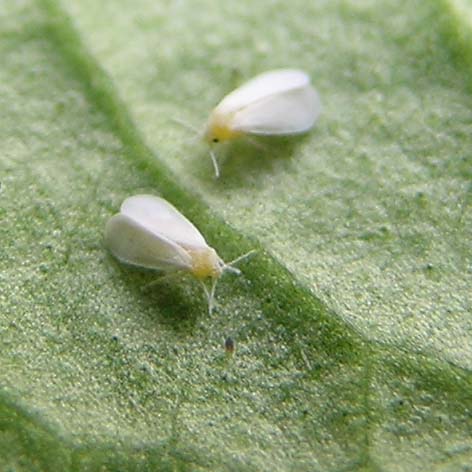What are Whiteflies?
Despite their name, whiteflies are not true flies. They tiny, soft bodied fly-like insects in the same insect Order (Homoptera) as aphids, leafhoppers, mealybugs and scale insects. They have thin, membrane-like wings and they coat their bodies and wings with a wax-like substance secreted by glands on their abdomens, which makes them appear white.
Damage Done by Whiteflies
Whiteflies feed off plants by sucking the plant's juices. They can cause wilting, stunting and death.
Like aphids, whiteflies also secrete honeydew, a sticky residual substance that coats the plant leaves. Molds, called "sooty molds" because they are dark colored, can then grow on this honeydew, making vegetables and fruits less desirable and possible weakening the plant by blocking photosynthesis.
Probably the most damaging aspect of whiteflies is that they can carry viruses from one plant to another. As with their relatives the aphids, mealybugs and scale, a whitefly population can grow quickly. Females do not need to mate to produce eggs and can lay up to 200 at one time. In optimal temperatures, (65 to 75 degrees F.), it takes less than 40 days to go from egg to adult. So you can see why whiteflies are a major pest in greenhouses.
Harm-insects: share some docs I 've saved
Controlling Whiteflies
The best way to control whiteflies is to constantly monitor for them and use a combination of techniques to keep their population down.
- First, be cautious not to bring whiteflies in with new plant purchases. Since whiteflies are so prevalent in greenhouses, new plants can easily be infested. However whiteflies are hard to miss. Simply disturbing the plant will cause them to flutter about like a cloud. To be safe, do a through inspection of the underside of leaves, where they hide.
- Monitor for whiteflies with yellow sticky traps. Hang or mount the traps near your plants and check often. These traps will not only tell you if you have a whitefly problem, they will also catch quite a few of them.
- Small infestations can be washed off with a blast of water or by sinking the plant in a bucket of water.
- Sprays containing pyrethrum or neem offer some control to existing whitefly infestations. Coat both the upper and lower surfaces of leaves. Repeat applications will need to be made.
(gardening.com)
Despite their name, whiteflies are not true flies. They tiny, soft bodied fly-like insects in the same insect Order (Homoptera) as aphids, leafhoppers, mealybugs and scale insects. They have thin, membrane-like wings and they coat their bodies and wings with a wax-like substance secreted by glands on their abdomens, which makes them appear white.
Damage Done by Whiteflies
Whiteflies feed off plants by sucking the plant's juices. They can cause wilting, stunting and death.
Like aphids, whiteflies also secrete honeydew, a sticky residual substance that coats the plant leaves. Molds, called "sooty molds" because they are dark colored, can then grow on this honeydew, making vegetables and fruits less desirable and possible weakening the plant by blocking photosynthesis.
Probably the most damaging aspect of whiteflies is that they can carry viruses from one plant to another. As with their relatives the aphids, mealybugs and scale, a whitefly population can grow quickly. Females do not need to mate to produce eggs and can lay up to 200 at one time. In optimal temperatures, (65 to 75 degrees F.), it takes less than 40 days to go from egg to adult. So you can see why whiteflies are a major pest in greenhouses.
Harm-insects: share some docs I 've saved
Controlling Whiteflies
The best way to control whiteflies is to constantly monitor for them and use a combination of techniques to keep their population down.
- First, be cautious not to bring whiteflies in with new plant purchases. Since whiteflies are so prevalent in greenhouses, new plants can easily be infested. However whiteflies are hard to miss. Simply disturbing the plant will cause them to flutter about like a cloud. To be safe, do a through inspection of the underside of leaves, where they hide.
- Monitor for whiteflies with yellow sticky traps. Hang or mount the traps near your plants and check often. These traps will not only tell you if you have a whitefly problem, they will also catch quite a few of them.
- Small infestations can be washed off with a blast of water or by sinking the plant in a bucket of water.
- Sprays containing pyrethrum or neem offer some control to existing whitefly infestations. Coat both the upper and lower surfaces of leaves. Repeat applications will need to be made.
(gardening.com)

